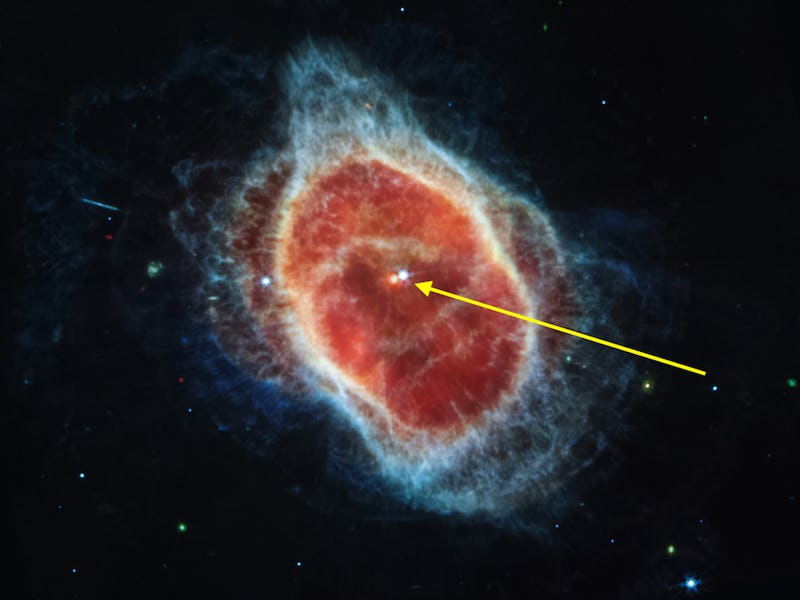Webb Telescope first images: 6 cosmic Easter eggs you might have missed
Feeling overwhelmed? We know the feeling.

The James Webb Space Telescope promised the world one thing: It would unveil the Universe to a degree of detail and precision never before accomplished by any space observatory built by humankind. On July 12, the myriad scientists around the world who poured their life’s work into making good on that promise were vindicated.
The Webb Telescope is a new era for astronomy and science. Scientists have no idea what they might discover with Webb. But with five observations taken in just one week of operation, they have already found several cosmic Easter eggs that defy expectations — including a few complete and utter unknowns.
Let’s take a tour through six of the most revelatory and intriguing Easter eggs hidden in the first five James Webb Space Telescope observations.
6. A galactic interloper — or two
Can you find them all?
How many galaxies can you see in this image? Hey, you’re already looking at an exploding star — what more can you want? How about at some galaxies hiding in the chaos?
On the far left of the nebula, astronomers noticed the jet-like structure seemingly emanating from the Southern Ring Nebula — but psyche! It’s actually a galaxy seen from the side, hence the strangely flat appearance. If you zoom into the image, you can spot more galaxy-like structures, including a few with beautiful spiral-arm arrangements.
5. Surprise! It’s not one star.
Where did you come from?
The Southern Ring Nebula has always been supposed to be a single dying star. As an older Hubble image of the nebula hints, it appeared very clearly to the casual observer that this was a one-star show. But thanks to Webb, we now know that’s not quite right. There’s a supporting actor lurking in the shadows after all.
For the first time, astronomers have imaged the star pair to discover that the fainter star is in fact shrouded in dust and gas and may be within the system. The discovery was made possible by Webb’s instrument MIRI — using a different Webb instrument, the star’s details would have remained obscured as in the older Hubble image.
4. Weather forecasting on WASP-96b
Water!
WASP-96b is one of the thousands of confirmed exoplanets in our galaxy. With 0.48 times the mass yet 1.2 times the size of Jupiter, this puff-ball planet orbits a Sun-like star 1,150 light-years away every three-and-a-half days.
Webb’s observation of WASP-96b is a little difficult to interpret because it is a spectrograph — a chart showing the chemical composition of molecules within the planet’s atmosphere. But this first exoplanet spectrum from Webb reveals hidden details about WASP-96b. Obviously, the chart shows the presence of water molecules. But it also reveals a totally unexpected weather phenomenon: Clouds.
3. Hungry, hungry black hole
Devastating.
Stephan’s Quintet is a bit of a misnomer — it looks like five galaxies in close proximity to one another, but it is actually four galaxies in close proximity and one galaxy (farthest left) is essentially photobombing the cluster from its location some 250 million light-years closer to Earth than the other four.
The image is beautiful, but it also reveals a secret of the top-most galaxy, NGC 7319. This galaxy has a behemoth at its center — a supermassive black hole that is 240 million times the mass of the Sun. This monster of the cosmos is visible (indirectly) in this image in the form of the massive amounts of light jetting from it as it consumes dust, gas, and other material within the galaxy. Its light is so bright, that it outshines the galaxy’s other features.
2. Are these the furthest galaxies ever imaged?
13 billion.
Webb’s deep field study of galaxy cluster SMACS 0723 reveals a host of sparkling-bright galaxies, many of which sit some 4.5 billion light-years from Earth. In the life and span of the Universe, we’re getting into the teenage territory — the Universe is estimated to be 13.8 billion years old. But look closely at the shinier objects, and you see the red and orange dust-like specks of other, much older, much more distant galaxies, thrown into focus using gravitational lensing. (Want to learn more? We got you.)
These primordial galaxies are the faintest objects in the Universe ever observed. But here’s the thing: We don’t actually precisely know how old or distant they might be at this point — but the two motes pointed out here come to us by way of light that traveled 13 billion (top left) and 13.1 billion (mid-left) years.
1. Stellar nursery structures — what even are these?
Is it a cosmic ostrich, hiding its head in the sand?
“What is even going on here?” That’s the question Amber Straughn, NASA scientist and Webb team member, asked as she unveiled the Webb Telescope’s image of a star-making factory within the Carina Nebula. Straughn made the remark as she gestured around a strangely tube-like structure — which we have zoomed into for your convenience — within the dust and gas cliffs of NGC 3324, a particular region of the Carina Nebula.
Great question!
NASA has this brief explanation to share: “The blistering, ultraviolet radiation from the young stars is sculpting the nebula’s wall by slowly eroding it away. Dramatic pillars tower above the glowing wall of gas, resisting this radiation. The “steam” that appears to rise from the celestial “mountains” is actually hot, ionized gas and hot dust streaming away from the nebula due to the relentless radiation.”
Each new observation of Webb could mean a new discovery about our Universe. Keep up to date with the latest by following our coverage at our James Webb Space Telescope news hub.